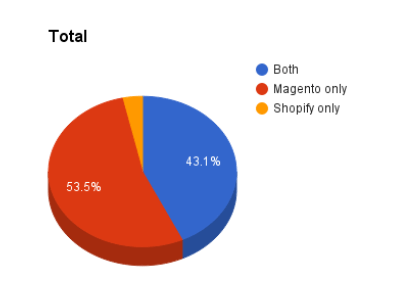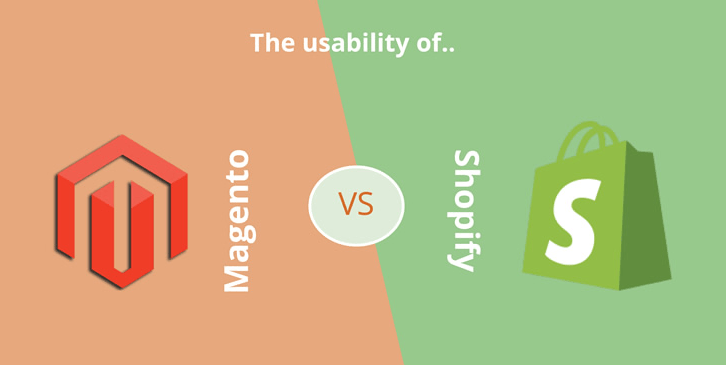
Magento and Shopify are the two largest e-commerce platforms today. It’s hard to answer the question: Which is the best e-commerce platform? Because this answer depends heavily on demand, investment amount, business scale, desired features… Of you. Before making the decision that will use open source, read the following article now!
In this article, I will compare two Magento and Shopify platforms together in a variety of backgrounds so that you can better understand the strengths and weaknesses of each platform, thereby making a final decision for your own.

1. Magento vs Shopify: Features
One of the first things you consider and consider when choosing an e-commerce platform is the features that this platform has to be.

Basic online functionality
Both of these two platforms offer some great functionality. In comparison, it looks like Magento has more features. 53.5% of the features are available exclusively for Magento and 43.1% for both platforms, while Shopify is modest at only 3.1%.
Inventory Management
Both Shopify and Magento don’t limit the number of products you can list in your inventory.
Article Note: With Magento, you should be careful when adding too many products as this is the cause of hosting (VPS, server) with page loading speeds that may be affected. That’s why you need an appropriate structure and a long-lasting plan for your business expansion, expanding your store. With Shopify, you won’t have that problem because it has more appropriate management and storage solution.
Themes and templates
Magento offers a variety of free themes and templates as well as a variety of fees to choose from. Magento’s paid themes also tend to be less expensive because the purchase price starts at $1 while Shopify is $80 cheating.
However, themes offered by Shopify are more friendly and contemporary. Both of these platforms are compatible with mobile and will not bother you with a smartphone user experience.
Apps and ADD-ons
Magento has defeated Shopify when referring to additional apps and add-ons on the platform.
The next month’s stats to the 6/2016 Magento extension market already have more than 9486 apps while Shopify is modest only around 539. This is probably the result of the open-source environment for Magento, which encourages programmers, developers to contribute and create many tools on this platform.
Multilingual capabilities
If you want to create a shopping website that not only serves customers in Vietnam but also expands in more than 1 language, than one, then you will have a big problem with Shopify. This platform does not allow you to do it directly but must buy an additional third-party application.
There is another way to get the theme code to fix it, but this is hard work, not to do it, by reediting the source code is not easy.
Features for Bloggers
Shopify has a built-in function to create a blog and is pretty easy to install. While Magento you must install additional plugins for free and a few taps to set up.
1. Magento vs Shopify: Features

User interface
Both platforms have a user interface and a dashboard that is easy to get used to. And it looks like Shopify goes ahead 1 step when it comes to usability.
Setup/Installation
Shopify has a wizard mode, which allows users to set up an online store with extremely fast timing. You can create an e-commerce site within a few minutes.
On the contrary, setting up Magento is not easy and you can’t do it 1 yourself if you don’t know programming, on the system. This means that you need a British developer of the Magento source code next to it.
Flexibility
Magento is the open-source platform so it’s more flexible and you can change it the way you want. You can use the source code and re-edit it, add new features without spending any costs on paying for the app.
Of course, this causes time-consuming and resources, even the self-correction cost is much more costly than the money out to buy available applications.
Shopify is a closed platform, so you can’t change the source code. But you can still develop apps for this source and sell them by putting the product on the App Store.
3. Magento vs Shopify: Support capability

Unlike Shopify, Magento community versions don’t give you any support so you need to solve your problems yourself. The only thing you can expect is the support from the community or other developers through the general forums. And if you’re lucky, an error you’ve encountered that you’ve encountered, your community’s response will bring you less value so you can find a solution to your problem. Magento Enterprise Edition is still supported normally.
4. Magento vs Shopify: Storage and security
Unlike Shopify, Magento community versions don’t give you any support so you need to solve your problems yourself. The only thing you can expect is the support from the community or other developers through the general forums. And if you’re lucky, an error you’ve encountered that you’ve encountered, your community’s response will bring you less value so you can find a solution to your problem. Magento Enterprise Edition is still supported normally.
You’ll need a place to store and security for running an e-commerce site and is interesting because both Magento and Shopify have different approaches to this problem.
Hosting
Shopify concern always for sale to put the source code and if you always need them for free to your domain set up for your website anymore. This makes it easier to install e-commerce sites, and of course their own every month you will lose a maintenance fee.
Magento is different, though the commercial version is free, however, you need to search and set up your server. Magento uses a lot of resources for both setups and commissioning so the little, cheap resource packs are not enough to meet. It’s best to use 1 private virtual server (VPS) to make your website work smoothly, as the number of products grows, or a higher simultaneous access customer.
Besides, with Magento, you should also purchase more CDN to optimize access and load the system.
Security
Because Shopify has already served to host needs, so Shopify will also be responsible for securing the source code as well as its system. You can use the SSL certificate for the website, auto Backup, and PCI compliance level 1.
Magento also has PCI certification and SSL Security support.
5. Magento vs Shopify: Marketing

Unlike Shopify, Magento community versions don’t give you any support so you need to solve your problems yourself. The only thing you can expect is the support from the community or other developers through the general forums. And if you’re lucky, an error you’ve encountered that you’ve encountered, your community’s response will bring you less value so you can find a solution to your problem. Magento Enterprise Edition is still supported normally.
SEO Capabilities
Magento offers interesting features like friendly SEO URLs, meta information, Google Sitemap, Google content API to expand your SEO capabilities. Shopify has the basic features you need such as the robots. txt file, sitemap. XML, standard URL tags to avoid content duplication, editable meta descriptions, header tags, and URLs.
Both platforms are easy to integrate with Google Analytics so that you can track the traffic that you create from search engines.
Social media features
Unfortunately, Magento does not offer this feature. However, you can integrate additional apps to create the feature you need. Shopify scores in this section as they provide options for you to promote your products on Facebook and Pinterest.
News Feed (Newsletter)
Magento offers better newsletter subscription services than Shopify. The news feed here is a message to the guest’s mail, indicating if your business is having any promotions… You can integrate your source code system with coupons (coupons) and run promotional events directly in your newsletter.
However, the majority of people opt for external services such as MailChimp, SendGrird, GetRresponse to send emails as marketing, bulk emails. This is quite useful as the mail service of these providers will be better and ensure mail delivery to Inbox is better than the source mail system and above all the mail Service administration is always difficult and only for the sysadmin has Experienced.
Promotion customization
Magento scores at this issue when offering integrated features such as price increases, promotions, flexible coupons, related products, free shipping, product combinations…
Additionally, you can install additional free add-ons to create additional advertising functionality.
With Shopify discount codes and coupons is the available functionality, but with other functions, you have to give up your budget to buy.
Support for other sales channels
Both platforms allow you to integrate and sell products in other channels. Magento has a list of customer codes taken in an application from the expanding marketplace that helps you integrate and sell across other channels. You will also have Google Shopping API, however, you need a little experience to develop it and integrate into the system without problems.
With Shopify, you can also easily sell products through Google Product, so that you can simply contact your Shopify source code provider for additional support. You can also use the app to sell items on eBay, Amazon.
Data analysis and statistics
Magento provides you with a detailed and comprehensive report that measurements are quite complex. You get reporting metrics on sales, tax, refund, invoices, product reviews, and most viewed products… There are also statistics on the keywords that customers search for products on your page. You’ll see this statistic right on your dashboard.
With Shopify, the report is often easier to understand and simpler, of course losing Magento because the reports don’t provide a lot of information. Shopify’s reporting metrics include sales, traffic coming from any location, referring page, device, total revenue divided by the location that customers buy…
6. Magento vs Shopify: Cost

Unlike Shopify, Magento community versions don’t give you any support so you need to solve your problems yourself. The only thing you can expect is the support from the community or other developers through the general forums. And if you’re lucky, an error you’ve encountered that you’ve encountered, your community’s response will bring you less value so you can find a solution to your problem. Magento Enterprise Edition is still supported normally.
SEO Capabilities
Magento offers interesting features like friendly SEO URLs, meta information, Google Sitemap, Google content API to expand your SEO capabilities. Shopify has the basic features you need such as the robots. txt file, sitemap. XML, standard URL tags to avoid content duplication, editable meta descriptions, header tags, and URLs.
Both platforms are easy to integrate with Google Analytics so that you can track the traffic that you create from search engines.
Social media features
Unfortunately, Magento does not offer this feature. However, you can integrate additional apps to create the feature you need. Shopify scores in this section as they provide options for you to promote your products on Facebook and Pinterest.
News Feed (Newsletter)
Magento offers better newsletter subscription services than Shopify. The news feed here is a message to the guest’s mail, indicating if your business is having any promotions… You can integrate your source code system with coupons (coupons) and run promotional events directly in your newsletter.
However, the majority of people opt for external services such as MailChimp, SendGrird, GetRresponse to send emails as marketing, bulk emails. This is quite useful as the mail service of these providers will be better and ensure mail delivery to Inbox is better than the source mail system and above all the mail Service administration is always difficult and only for the sysadmin has Experienced.
Promotion customization
Magento scores at this issue when offering integrated features such as price increases, promotions, flexible coupons, related products, free shipping, product combinations…
Additionally, you can install additional free add-ons to create additional advertising functionality.
With Shopify discount codes and coupons is the available functionality, but with other functions, you have to give up your budget to buy.
Support for other sales channels
Both platforms allow you to integrate and sell products in other channels. Magento has a list of customer codes taken in an application from the expanding marketplace that helps you integrate and sell across other channels. You will also have Google Shopping API, however, you need a little experience to develop it and integrate into the system without problems.
With Shopify, you can also easily sell products through Google Product, so that you can simply contact your Shopify source code provider for additional support. You can also use the app to sell items on eBay, Amazon.
Data analysis and statistics
Magento provides you with a detailed and comprehensive report that measurements are quite complex. You get reporting metrics on sales, tax, refund, invoices, product reviews, and most viewed products… There are also statistics on the keywords that customers search for products on your page. You’ll see this statistic right on your dashboard.
With Shopify, the report is often easier to understand and simpler, of course losing Magento because the reports don’t provide a lot of information. Shopify’s reporting metrics include sales, traffic coming from any location, referring page, device, total revenue divided by the location that customers buy…
Setup Cost
With Shopify, you don’t need to pay any additional costs for setup. At the same time, they also give you a free 14-day trial for you to create an e-commerce store that tests the features before deciding whether to buy always.
Magento commercial version also does not need setup costs at all, however, you may need to hire a dev staff member (programmer) to develop and create online trading shops for you.
Besides, you need to pay the rental hosting (server) and the money purchased domain. If you don’t have two things, of course, your website won’t work.
Monthly expenses
Shopify has 4 different packages depending on the needs and features you want. Namely the following:
– Shopify Life – $4 per month – the lowest plan and allows you to set up Facebook’s store linking feature.
– Shopify Basic – 29 $/month – provides the most basic features.
– Shopify – $79/month – Provide the most popular features you need.
– Shopify Advanced – 299 $ per month – offers more premium features.
Besides, the Shopify Plus package offers to customers on the business floor.
All of the above packages do not limit the number of products, storage files, free hosting, domain and SSL certificates.
Magento Community Version: free, however, the pre-maintained domain and hosting (server) is located about $5 – $100 depending on your needs.
Magento Enterprise Edition: Has a license of 18,000 $ per year, not to mention you need to hire a dev staff with a salary of between $10 – 15 $/1h.
Traffic Charge (bandwidth)
Shopify does not add a traffic fee, whereas Magento is dependent on the hosting provider (server). So if your options are Magento platform, you should opt for the unlimited bandwidth provider.
Transaction fee
With Shopify: In case you use Shopify’s payment gateway, it’s free.
If you use a different method of payment gateway, you’ll have to pay an additional fee as follows:
– Shopify Lite ($ 9/month): 2%
– Shopify Basic ($ 29/month): 2%
– Shopify ($ 79/month): 1%
– Shopify Advanced ($299/month): 0.5%
The Credit Card level that you’re charged is:
– Shopify Lite ($ 9/month): 2.9% $0.30
– Shopify Basic ($ 29/month): 2.9% $0.30
– Shopify ($ 79/month): 2.6% $0.30
– Shopify Advanced ($299/month): 2.4% $0.30
With Magento, you will pay additional transaction fees based on the payment gateway that you use, which will change depending on the solution you use.
Theme/Template Cost
Both platforms have a lot of free and paid themes and templates (of course Magento richer).
7. The general conclusion
Shopify provides solutions easy to set up and use, you will not need to bother looking for a place to store your source code. This platform also provides great support and always available when you need it.
Disadvantages of this platform are closed source, you can not change things in the source code as well as a poor application store.
Magento is an open-source platform with more flexibility, you total manage and creates e-commerce sites in the way that you want. Functional building better marketing and warehouse Shopify with rich applications are contributions from the community.
Disadvantages of this platform are the community version you will hardly seek good support if you like you have money to buy the commercial version.
Personally, Magento offers more features, but if you want everything operating smoothly and most stable way, surely you must need at least one IT employee (developer system).
And you, you think of how the difference when comparing the war Magento and Shopify e-commerce source code? Thank you watched. We hope you’ll come up with a final decision for your business.

